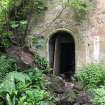Buildings at Risk Register Paused
Following the review of the Buildings at Risk Register the decision has been taken to pause the BARR in order to consider long-term options for its future.
The existing BARR website will remain accessible as a resource, however it will not be updated and we're not accepting nominations for additions to the Register.
Downtime
Please be advised that this website will undergo scheduled maintenance on the following dates:
Sunday 23rd November 18:00 to Monday 24 November 09:00
Dunmore Park Tower, Dunmore
Ordnance Survey licence number AC0000807262. All rights reserved. © Copyright and database right 2025. Public Sector Viewing Terms
Useful Links
- NRHE:
- DUNMORE PARK, ELPHINSTONE TOWER, AIRTH TOWER
- Historic Scotland:
- HS Reference No 2111
General Details and Location
Category
AT RISK
Name of Building
Dunmore Park Tower
Other Name(s)
Airth Tower; Elphinstone Tower
Address
Dunmore
Locality
Postcode
Planning Authority
Divisional Area
Reference No
2383
Listing Category
C
OS Grid Ref
NS 89018 88922
Location Type
Rural
HS Reference No
2111
Description
Rubble-built rectangular-plan tower, once measuring 9 x 7.4m but now greatly diminished. The walls measure some 5'9" thick in most sections, and each of the 4 floors once held a single room. The doors, windows and battlements are Victorian additions, as was the conical fishscale-slated turret which has now been lost. The tower is enclosed to the south and west by the graveyard of the demolished Episcopal Church and remains one of the few estate buildings to predate the 19th century remodelling.
Originally built in 1504 by Sir John Elphinstone, it was known as the Elphinstone Tower for the next 250 years before the estate was bought by John, 4th Earl of Dunmore in 1754 and was renamed Dunmore Park. The ground floor of the tower was later converted into the family's burial vault.
Originally built in 1504 by Sir John Elphinstone, it was known as the Elphinstone Tower for the next 250 years before the estate was bought by John, 4th Earl of Dunmore in 1754 and was renamed Dunmore Park. The ground floor of the tower was later converted into the family's burial vault.
Building Dates
1504; 19th century
Architects
Unknown
Category of Risk and Development History
Condition
Ruinous
Category of Risk
High
Exemptions to State of Risk
Field Visits
01/06/1996, 01/01/1998, 09/10/2008, 13/3/2015
Development History
September 1980: Demolition consent is sought. A substantial section of walling at the north-west corner has collapsed. However, a feasibility study into restoration as a holiday let has also been completed. The estate was split up and sold as separate lots in 1968. 28 February 1986: Press reports note that several graves within the tower have been desecrated. The tower is now owned by Edinburgh businessman Anthony Zawadesky and has been purchased on behalf of the Castellan Society, which purchases properties for restoration and is currently seeking charitable status. However, responsibility for maintaining and securing the graves rests with the trustees of 2 Episcopalian Church memorial funds via Stuart and Stuart, Cairns Solicitors of Edinburgh and the owner does not intend to commence restoration until this has been undertaken. March 1991: SCT understands the tower is now owned by a Mr Eric Munnoch of Dunmore Village. Planning Permission exists for restoration as a holiday home. 19 September 1991: The Falkirk Herald reports that a 6-foot fence has been erected around the tower. It is reported that developers Kelvin Homes and hoteliers Tirena are interesting in restoring the tower as part of their leisure development proposals for the estate. May 1996: Permissions are sought by Dunmore Developments for alterations and extension to form a dwelling. The Victorian fishscale turret has now collapsed and the tower suffers from vandalism. SCT welcomes the application. 1997: Permissions are granted. January 1998: External inspection reveals the tower to be ruinous, with the entire northern flank now collapsed. 20 May 2004: The Falkirk Herald reports that Dunmore Developments hopes to resurrect its plans to restore the tower as a dwelling, for which permissions were granted in 1997. Original coffins have now been disinterred from the tower and moved to Blair Atholl, though the coffin lids remain. A visitor to the tower notes that it has suffered severe vandalism.
October 2008: External inspection reveals that the tower remains ruinous. The eastern half survives with the walls relatively intact though overgrown. The interior is overgrown.
13 March 2015: External inspection finds the building remains in much the same condition as seen previously. Risk level reduced to High.
12 July 2019: External inspection finds this tower in much the same condition as seen previously - much of the structure ruinous, the most eastern being the most intact. Extensive tree and vegetation growth prevented full visual survey of structure.
2 August 2022: The property is being marketed for sale through appointed agent Slater Hogg & Howison, Falkirk, at offers over £80,000.
12 January 2023: Property continues to be marketed for sale by the agent Slater Hogg & Howison, Falkirk. The asking price is now offers over £78,000.
8 February 2024: No longer being marketed for sale.
Guides to Development
Conservation Area
Planning Authority Contact
PAC Telephone Number
01324 504715
Availability
Current Availability
Unknown
Appointed Agents
Price
Occupancy
Vacant
Occupancy Type
N/A
Present/Former Uses
Name of Owners
Dunmore Developments
Type of Ownership
Company
Information Services
Additional Contacts/Information Source
Bibliography
Coventry (2001), p49; Dean and Miers (1990), pp26-27; Jaques (2001), p67; Tait (1980); Stirlingshire: An Inventory of the Ancient Monuments, pp229-230.
Online Resources
Classification
Castles, Palaces and Fortified Houses
Original Entry Date
19-SEP-90
Date of Last Edit
08/02/2024




















